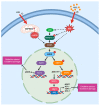Pathophysiological Impact of the MEK5/ERK5 Pathway in Oxidative Stress
- PMID: 37190064
- PMCID: PMC10136880
- DOI: 10.3390/cells12081154
Pathophysiological Impact of the MEK5/ERK5 Pathway in Oxidative Stress
Abstract
Oxidative stress regulates many physiological and pathological processes. Indeed, a low increase in the basal level of reactive oxygen species (ROS) is essential for various cellular functions, including signal transduction, gene expression, cell survival or death, as well as antioxidant capacity. However, if the amount of generated ROS overcomes the antioxidant capacity, excessive ROS results in cellular dysfunctions as a consequence of damage to cellular components, including DNA, lipids and proteins, and may eventually lead to cell death or carcinogenesis. Both in vitro and in vivo investigations have shown that activation of the mitogen-activated protein kinase kinase 5/extracellular signal-regulated kinase 5 (MEK5/ERK5) pathway is frequently involved in oxidative stress-elicited effects. In particular, accumulating evidence identified a prominent role of this pathway in the anti-oxidative response. In this respect, activation of krüppel-like factor 2/4 and nuclear factor erythroid 2-related factor 2 emerged among the most frequent events in ERK5-mediated response to oxidative stress. This review summarizes what is known about the role of the MEK5/ERK5 pathway in the response to oxidative stress in pathophysiological contexts within the cardiovascular, respiratory, lymphohematopoietic, urinary and central nervous systems. The possible beneficial or detrimental effects exerted by the MEK5/ERK5 pathway in the above systems are also discussed.
Keywords: ERK5; KLF2/4; MEF2; RNS; ROS; antioxidant response; oxidative damage; oxidative stress.
Conflict of interest statement
The authors declare no conflict of interest.
Figures

Similar articles
-
Erk5 inhibits endothelial migration via KLF2-dependent down-regulation of PAK1.Cardiovasc Res. 2015 Jan 1;105(1):86-95. doi: 10.1093/cvr/cvu236. Epub 2014 Nov 10. Cardiovasc Res. 2015. PMID: 25388666
-
MEK5 and ERK5 are localized in the nuclei of resting as well as stimulated cells, while MEKK2 translocates from the cytosol to the nucleus upon stimulation.J Cell Sci. 2004 Apr 1;117(Pt 9):1773-84. doi: 10.1242/jcs.01040. Epub 2004 Mar 16. J Cell Sci. 2004. PMID: 15075238
-
Ubiquitin-dependent regulation of MEKK2/3-MEK5-ERK5 signaling module by XIAP and cIAP1.EMBO J. 2014 Aug 18;33(16):1784-801. doi: 10.15252/embj.201487808. Epub 2014 Jun 28. EMBO J. 2014. PMID: 24975362 Free PMC article.
-
The MEK5/ERK5 Pathway in Health and Disease.Int J Mol Sci. 2021 Jul 15;22(14):7594. doi: 10.3390/ijms22147594. Int J Mol Sci. 2021. PMID: 34299213 Free PMC article. Review.
-
The MEK5/ERK5 signalling pathway in cancer: a promising novel therapeutic target.Drug Discov Today. 2016 Oct;21(10):1654-1663. doi: 10.1016/j.drudis.2016.06.010. Epub 2016 Jun 16. Drug Discov Today. 2016. PMID: 27320690 Review.
Cited by
-
Gut matters in microgravity: potential link of gut microbiota and its metabolites to cardiovascular and musculoskeletal well-being.Nutr Metab (Lond). 2024 Aug 9;21(1):66. doi: 10.1186/s12986-024-00836-6. Nutr Metab (Lond). 2024. PMID: 39123239 Free PMC article. Review.
-
Effects of Radiation-Induced Skin Injury on Hyaluronan Degradation and Its Underlying Mechanisms.Molecules. 2023 Nov 6;28(21):7449. doi: 10.3390/molecules28217449. Molecules. 2023. PMID: 37959868 Free PMC article.
-
PIEZO1 Overexpression in Hereditary Hemorrhagic Telangiectasia Arteriovenous Malformations.Circulation. 2025 Jul 16:10.1161/CIRCULATIONAHA.124.073630. doi: 10.1161/CIRCULATIONAHA.124.073630. Online ahead of print. Circulation. 2025. PMID: 40665909
-
Therapeutic Approaches for the Treatment of Interstitial Lung Disease: An Exploratory Review on Molecular Mechanisms.Mini Rev Med Chem. 2024;24(6):618-633. doi: 10.2174/1389557523666230816090112. Mini Rev Med Chem. 2024. PMID: 37587813 Review.
-
Methylglyoxal in Cardiometabolic Disorders: Routes Leading to Pathology Counterbalanced by Treatment Strategies.Molecules. 2023 Nov 24;28(23):7742. doi: 10.3390/molecules28237742. Molecules. 2023. PMID: 38067472 Free PMC article. Review.
References
Publication types
MeSH terms
Substances
LinkOut - more resources
Full Text Sources
Medical
Miscellaneous

